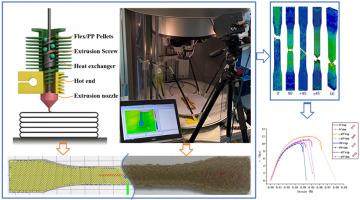天然纤维增强复合材料的熔融粒状制造:亚麻/聚丙烯结构的实验和数值分析
IF 4.5
2区 化学
Q2 POLYMER SCIENCE
引用次数: 0
摘要
采用熔融颗粒制造(FGF) 3D打印技术制备了不同光栅方向(0°、45°、90°和±45°)的亚麻纤维增强聚丙烯(亚麻/PP)复合材料,并通过数字图像相关(DIC)进行拉伸测试。±45°打印的样品具有最高的抗拉强度(~ 12.7 MPa)和刚度,而90°打印的样品由于层间结合弱而表现出最差的性能。扫描电镜显示了不同的断裂模式(0°时纤维拔出,90°时层脱层),解释了强度差异。采用有限元模型对应力分布和破坏进行模拟,预测结果与实验结果吻合较好(误差≤0.18)。这些研究结果表明,±45°的光栅取向优化了界面粘附和负载分布,提供了最佳的整体拉伸性能。该研究强调了FGF打印、全场应变测量和模拟相结合的有效性,为亚麻/PP复合材料的最佳打印策略提供了信息。本文章由计算机程序翻译,如有差异,请以英文原文为准。


Fused granular fabrication of natural fiber reinforced composites: Experimental and numerical analysis of flax/PP structures
Flax fiber‐reinforced polypropylene (Flax/PP) composites were fabricated via fused granular fabrication (FGF) 3D printing at various raster orientations (0°, 45°, 90°, and ±45°) and evaluated by tensile testing with digital image correlation (DIC). The ±45° printed specimens achieved the highest tensile strength (∼12.7 MPa) and stiffness, whereas the 90° specimens showed the poorest performance due to weak inter-layer bonding. Scanning electron microscopy revealed distinct fracture modes (fiber pull-out at 0° vs. layer delamination at 90°), explaining the strength differences. Finite element modeling was performed to simulate stress distribution and failure, and the predictions showed strong agreement with experimental results (error ≤0.18). These findings demonstrate that a ±45° raster orientation optimizes interfacial adhesion and load distribution, providing the best overall tensile performance. The study highlights the effectiveness of combining FGF printing, full-field strain measurement, and simulation to inform optimal printing strategies for Flax/PP composites.
求助全文
通过发布文献求助,成功后即可免费获取论文全文。
去求助
来源期刊

Polymer
化学-高分子科学
CiteScore
7.90
自引率
8.70%
发文量
959
审稿时长
32 days
期刊介绍:
Polymer is an interdisciplinary journal dedicated to publishing innovative and significant advances in Polymer Physics, Chemistry and Technology. We welcome submissions on polymer hybrids, nanocomposites, characterisation and self-assembly. Polymer also publishes work on the technological application of polymers in energy and optoelectronics.
The main scope is covered but not limited to the following core areas:
Polymer Materials
Nanocomposites and hybrid nanomaterials
Polymer blends, films, fibres, networks and porous materials
Physical Characterization
Characterisation, modelling and simulation* of molecular and materials properties in bulk, solution, and thin films
Polymer Engineering
Advanced multiscale processing methods
Polymer Synthesis, Modification and Self-assembly
Including designer polymer architectures, mechanisms and kinetics, and supramolecular polymerization
Technological Applications
Polymers for energy generation and storage
Polymer membranes for separation technology
Polymers for opto- and microelectronics.
 求助内容:
求助内容: 应助结果提醒方式:
应助结果提醒方式:


